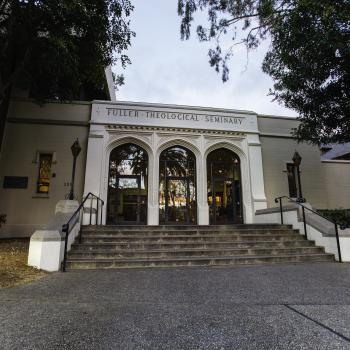By Dr. Tod Bolsinger
“No one would live in Boston without owning a winter coat. But countless people think that they can exercise leadership without partners…” –Ronald Heifetz
“I’m going to need new clothes,” my daughter warns me.
“It’s just a weekend trip,” I remind her.
“I mean, if I go to college there. If I do, then I’ll need a whole new winter wardrobe,” she says trying to demonstrate how reasonable she is being.
I have to concede her point. My eighteen-year-old soon-to-be college freshman is looking at two different schools that are in very different climates than the southern California beach city that she grew up in.
One in the Pacific Northwest, one in the upper Northeast. Both mean winters with lots of snow. Her stylish t-shirts and hoodie sweatshirts aren’t going to cut it, I know, and she is already planning the shopping spree. It is a reasonable, even necessary reality. She is going to need a winter coat, at least. And even tightwad Dad knows that.
But my daughter is also looking only at universities that support women in Christian leadership. And somewhere amidst the discussion of coats is a more important one about collaboration and the time of leadership needed in these harsher conditions of a rapidly changing, post-Christendom world.

Harvard Leadership guru Ronald Heifetz compares a winter coat with the need for partners in trying to survive the “harsh elements” of leadership. For Heifetz, leading alone is as foolish as my daughter trying to make it through a Boston winter wearing beach apparel.
But we do it all the time, don’t we?
Indeed many of us called to leadership think that the very concept of leadership is a solo endeavor. Our models are of the solitary commander with the weight on his shoulders. (Masculine pronoun intentional!)
Unfortunately, even those of us in Christian leadership default to this mental model. And it is deeply at odds with our own biblical witness.
When Jesus sent out his disciples, they went two by two. (Luke 10)
Jesus chose 12 apostles to carry on his mission, not an heir apparent. (John 20:21)
When the disciples ran into cultural issues, they appointed seven more leaders to share the load with them. (Acts 6)
When the first missionaries went forth, they went as teams and pairs. (Acts 13:1-5)
When a church was planted in Phillipi, it was a wife and husband pair that led the church. (Acts 18)
Many of Paul’s letters were co-authored. (1 Cor, 2 Cor, Phil, 1 Thes, 2 Thes, Philemon)
In spite of all of this, when we read passages like Ephesians 4 that list different forms or ‘gifts’ of leadership, we see different job roles and not a team of people working collaboratively together. And when churches go through a transition, they instinctively think of finding the new “head” pastor instead of what kind of leadership team would best serve the mission.
As a seminary professor and administrator, I know that even our education system works against collaborative leadership, teamwork and partnership. While it is changing, most professors are more comfortable with each student turning in her own paper, and faculty review committees give more weight to books and articles written alone than as a collaboration.
Indeed, most students find working alone on a paper or project more efficient and less relationally burdensome (who wants to have a hard confrontational discussion with a partner when there is an assignment to get done before mid-terms?), than having to work in groups.
But leadership is all about collaboration. And leadership that is taking risks, exploring new models, and charting new terrain, in a difficult changing world is even more so.
And frankly, in a day when we have seen writ large the risks of the single-superstar-celebrity pastor, why have we not celebrated and cultivated the good team, the strong partnership, the Lewis and Clarks, the Barnabas and Pauls, the Priscilla and Aquilas?
One of my consulting clients was thrust into a leadership role when her senior pastor was abruptly asked to resign—right in the middle of a huge organizational transition process. Not only was the church in the midst of change, but now they were without their leader. My client, who had been one of the associate pastors, was asked to shepherd the church through a very uncertain season. Frankly, most of the people in the pew assumed that she would just be a placeholder for a few days until a “real” interim pastor could be found.
To her, it didn’t matter if she was the associate pastor, the interim pastor, or the senior pastor. She just did the thing she does best: she gathered her colleagues together and they started collaborating, literally “co-laboring”. Together they talked, prayed, planned, prayed some more and talked even more. Soon a few days, turned into a few weeks, a few weeks into a few months and without fanfare, huge disruption or significant financial cost, the church slowly moved into its future preparing for a new pastor. The anxious church calmed down and continued their organizational transition. What was this bold leadership move? Convening the team. Co-laboring. She didn’t worry who was at the top of the pyramid. Indeed she threw out the pyramid and drew a circle.
Is it a surprise to me that it was a woman who led in this particular way? No, not really. My daughter, herself a young emerging leader, shows me all the time that her style of leading is very different than mine. And maybe when more women are in leadership we’ll see more collaboration and more Christian organizations better outfitted for the harsh winter of a changing world.
Tod Bolsinger is vice president for vocation and formation and assistant professor of practical theology at Fuller Theological Seminary. Prior to Fuller, Bolsinger served as senior pastor of San Clemente Presbyterian Church since 1997. With a Master of Divinity and a PhD in theology from Fuller Seminary, he has taught graduate-level classes in theology for the past 14 years at Fuller’s regional campus in Orange County. The author of two books, It Takes a Church to Raise a Christian: How the Community of God Transforms Lives and Show Time: Living Down Hypocrisy by Living Out the Faith, Bolsinger has also written a chapter about building community in a virtual world in the book The New Media Frontier: Blogging, Vlogging, and Podcasting for Christ. He has extensive experience in church and nonprofit consulting and executive coaching, and he blogs on church and leadership formation at bolsinger.blogs.com. You can follow him on Twitter at @todbol.
You can follow Fuller Seminary on Twitter at @fullerseminary.











